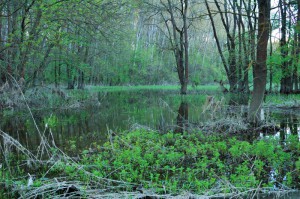Littoral forests and Swamp forests are also called wetland forests. India has a rich variety of these types of forests. They are mainly found in reservoirs of Deccan Plateau, saline coast of Gujarat, Rajasthan, and Gulf of Kutch, Eastern Coast Deltas, lakes and Rivers of Kashmir and Ladakh, Swamps in North East India. They are part of natural vegetation in India.

For the IAS Exam (Prelims and GS-I), candidates can read about other kinds of forests from the links mentioned in the table below:
| Evergreen Forests in India | Deciduous Forests in India |
| Montane Forests in India | Mangroves Forests in India |
About Littoral and Swamp Forest
- India has a rich variety of wetland habitats and the total area of wetland habitat is approximately 3.9 million hectares
- There are a total of eight categories into which the wetlands have been distributed in India. These include:
- The reservoirs of Deccan Plateau in the south together with lagoons and other wetlands of the south-west coast
- Rajasthan, Gujarat and Gulf of Kutch
- Freshwater lakes and reservoirs through Gujarat, Rajasthan and Madhya Pradesh
- Delta wetlands and lagoons of the east coast
- Freshwater marches of the Gangetic plain
- The Himalayan foothills and floodplains of Brahmaputra
- Lakes and rivers of the montane region of Kashmir
- The wetlands of Andaman and Nicobar Islands
Classification of Littoral Forests:
The Littoral forests can be classified into the following types:
- Beach forests: In the Beach forests, the rainfall varies from 75 cm to 500 cm depending upon the area. The temperature in these forests is moderate. The common plants found in these forests are Manilkara Littoralis, Thespesia, Spinifex Littoreus, Casuarina Equisetifolia, Pandanus, Borassus, Cocos Nucifera, Phoenix, Callophyllum Littoralis, Barringtonia, Pongamia. A number of twiners and climbers are also found in these forests.
- Tidal forests: The Tidal forests are also popularly known as the or Mangrove forests. Mangrove forests grow along the coast in the salt marshes, tidal creeks, and estuaries. It is home to a large variety of birds. The Tidal forests are further broadly classified into the following four types:
(i) Tree mangrove forests
(ii) Low mangrove forests
(iii) Saltwater forests and
(iv) Brackish water forests.
- Freshwater swamp forests: Important plants found here are Salix Tetrasperma, Acer, Putranjiva, Holoptelia, Cephalanthus, Barringtonia, Olea, Phoebe, Ficus, Murraya, Adhatoda, Canna and a variety of grasses.
Littoral Forests in India – UPSC Notes:- Download PDF Here
The topic, ‘Littoral & Swamp Forests’ is important from GS 1 syllabus perspective. Aspirants can get Mains GS 1 structure, strategy and syllabus in the linked article.
| Preparing for the upcoming UPSC Civil Services Exam? Complement your preparation with the links given below: |
Related Links:

Comments